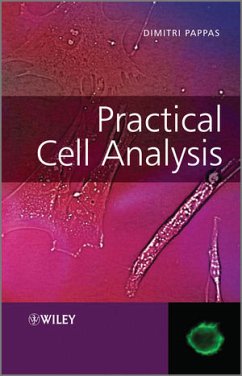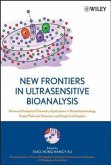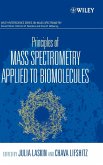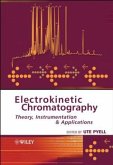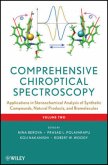Dimitri Pappas
Practical Cell Analysis
Dimitri Pappas
Practical Cell Analysis
- Gebundenes Buch
- Merkliste
- Auf die Merkliste
- Bewerten Bewerten
- Teilen
- Produkt teilen
- Produkterinnerung
- Produkterinnerung
Practical Cell Analysis serves as a guide for researchers interested in adding cell analyses to their repertoire. This book covers the basics of setting up a cell culture-capable laboratory, as well as sources and types of cells. In addition, the book also discusses the procedures for cell separation, handling cells on a microscope, and using cells in microfluidic devices. Cell viability, probe toxicity, apoptosis, cell storage, and other practical stumbling blocks are also discussed. Each chapter features useful tables such as common cell fluorescence probes and separation methods/protocols.
Andere Kunden interessierten sich auch für
![New Frontiers in Ultrasensitive Bioanalysis New Frontiers in Ultrasensitive Bioanalysis]() Xiao-Hong Nancy Xu (ed.)New Frontiers in Ultrasensitive Bioanalysis185,99 €
Xiao-Hong Nancy Xu (ed.)New Frontiers in Ultrasensitive Bioanalysis185,99 €![Biomolecules Biomolecules]() Chava Lifshitz / Julia Laskin (eds.)Biomolecules257,99 €
Chava Lifshitz / Julia Laskin (eds.)Biomolecules257,99 €![Chromatography Chromatography]() Robert L. Wixom / Charles W. GehrkeChromatography131,99 €
Robert L. Wixom / Charles W. GehrkeChromatography131,99 €![Electrokinetic Chromatography Electrokinetic Chromatography]() Ute PyellElectrokinetic Chromatography336,99 €
Ute PyellElectrokinetic Chromatography336,99 €![Cluster Secondary Ion Mass Spectrometry Cluster Secondary Ion Mass Spectrometry]() Christine M MahoneyCluster Secondary Ion Mass Spectrometry139,99 €
Christine M MahoneyCluster Secondary Ion Mass Spectrometry139,99 €![Mass Spectrometry in Drug Metabolism and Disposition Mass Spectrometry in Drug Metabolism and Disposition]() Mass Spectrometry in Drug Metabolism and Disposition192,99 €
Mass Spectrometry in Drug Metabolism and Disposition192,99 €![Comprehensive Chiroptical Spectroscopy, Volume 2 Comprehensive Chiroptical Spectroscopy, Volume 2]() Comprehensive Chiroptical Spectroscopy, Volume 2280,99 €
Comprehensive Chiroptical Spectroscopy, Volume 2280,99 €-
-
-
Practical Cell Analysis serves as a guide for researchers interested in adding cell analyses to their repertoire. This book covers the basics of setting up a cell culture-capable laboratory, as well as sources and types of cells. In addition, the book also discusses the procedures for cell separation, handling cells on a microscope, and using cells in microfluidic devices. Cell viability, probe toxicity, apoptosis, cell storage, and other practical stumbling blocks are also discussed. Each chapter features useful tables such as common cell fluorescence probes and separation methods/protocols.
Produktdetails
- Produktdetails
- Verlag: John Wiley & Sons / Turner Publishing Company
- Seitenzahl: 314
- Erscheinungstermin: 5. April 2010
- Englisch
- Abmessung: 229mm x 152mm x 23mm
- Gewicht: 590g
- ISBN-13: 9780470741559
- ISBN-10: 0470741554
- Artikelnr.: 28162195
- Verlag: John Wiley & Sons / Turner Publishing Company
- Seitenzahl: 314
- Erscheinungstermin: 5. April 2010
- Englisch
- Abmessung: 229mm x 152mm x 23mm
- Gewicht: 590g
- ISBN-13: 9780470741559
- ISBN-10: 0470741554
- Artikelnr.: 28162195
Dimitri Pappas is Assistant Professor in Analytical Chemistry at Texas Tech University. He obtained his B.S., University of Florida, 1998 followed by his Ph.D., University of Florida, 2002. He worked as a Research Scientist at Wyle Laboratories, NASA/Johnson Space Center, 2002-05 before taking up his post at Texas Tech. His key areas of research are: Analytical Fluorescence and Raman Spectroscopy; Cellular Analysis; Flow Cytometry; Optics With the focus on the interface between cell science and analytical chemistry. Dr. Pappas is currently developing novel analytical methods to study intact cells, cell digests, and tissue aggregates using spectroscopic and immunochemical techniques. The majority of his group's research is geared toward clinical analysis as well as medical testing in remote areas.
Chapter 1: Getting Starting (and Getting the Cells) 1.1 Introduction 1.2
The Driving Need 1.3 Primary and Cultured Cells 1.4 Choosing a Cultured
Cell 1.5 Choosing Primary Cells 1.6 Easily Obtainable Primary Cells 1.7
Primary Cells from Tissues 1.8 Purifying Primary Cells 1.9 How Long do
Primary Cells Remain Primary? 1.10 Obtaining Primary Cells from a
Commercial Source 1.11 Bacteria and Yeast 1.12 Practical Aspects of Cell
Culture 1.13 Safety Aspects of Primary and Transformed Cell Lines 1.14
Transfection of Primary and Transformed Cell Lines 1.15 Conclusion
References Chapter 2: The Cell Culture Laboratory (Tools of the Trade) 2.1
Introduction 2.2 Issues Concerning a Cell Laboratory 2.3 Setting up a Cell
Culture Laboratory 2.4 Cell Line Storage 2.5 Personal Protective Equipment
2.6 Cell and Sample Handling 2.7 Common Analytical Instrumentation for Cell
Culture 2.8 Considerations when Setting up a Cell Culture Laboratory 2.9
Establishing and Regulating A Culture Facility 2.10 Conclusion References
Chapter 3. Maintaining Cultures 3.1 Introduction 3.2 Medium 3.3 The Use of
Medium in Analysis, and Alternatives 3.4 Culturing Cells Protocol 3.1:
Sub-Culture of Adherent Cells 3.5 Growing Cells in Three Dimensions 3.6
Sterility and Contamination of Culture 3.7 Storage of Cell Samples and Cell
Lines Protocol 3.2: Cryopreservation of Mammalian Cells Protocol 3.3:
Retrieval of Cells from Liquid Nitrogen Storage 3.8 Conclusion References
Chapter 4. Microscopy of Cells 4.1 Introduction 4.2 Microscope Types 4.3
Culturing Cells for Microscopy 4.4 Signals, Background, and Artifacts in
Optical Microscopy 4.5 Staining Cells for Fluorescence Microscopy 4.6
Multiple Labels 4.7 Viability and Two-Photon Microscopy 4.8 Spatial
Resolution in Optical Microscopy 4.9 Image Saturation and Intensity 4.10
Atomic Force and Environmental Scanning Electron Microscopy 4.11 Conclusion
References Chapter 5: Separating Cells 5.1 Introduction 5.2 The Cell Sample
5.3 Label-Free (Intrinsic) Separations 5.4 Immunomagnetic Sorting 5.5 Cell
Affinity Chromatography 5.6 Affinity Chemistry Considerations in CAC and
MACS Separations Protocol 5.1: Screening of Antibody Clones 5.7 Elution in
Cell Affinity Chromatography 5.8 Nonspecific Binding in Cell Separations
5.9 Separation of Rare Cells 5.10 Fluorescence Activate Cell Sorting 5.11
Sorting Parameters 5.12 Other Separation Techniques and Considerations 5.13
Conclusion References Chapter 6. Flow Cytometry: Cell Analysis in the Fast
Lane 6.1 Introduction 6.2 The Cell Sample 6.3 Flow Cytometer Function 6.4
Obtaining or Finding a Flow Cytometer 6.5 Using Flow Cytometers 6.6 Setting
up a Flow Cytometer for Multi-Color Staining 6.7 Analyzing Flow Cytometry
Data 6.8 Example Flow Cytometry Assays 6.9 No-Flow Cytometry 6.10
Conclusion References Chapter 7: Analyzing Cells with Microfluidic Devices
7.1 Introduction 7.2 Advantages of Microfluidics 7.3 Considerations of
Microfluidics and Cells 7.4 Obtaining Microfluidic Cell Devices 7.5
Microfluidic Flow Cytometry 7.6 Cell Separations 7.7 Analysis of Cell
Products 7.8 Cell Culture Protocol 7.1: Low-shear Cell Culture Chip 7.9
Conclusion References Chapter 8: Statistical Considerations 8.1
Introduction 8.2 Types of Error 8.3 Figures of Merit in Statistical
Analysis of Cells 8.4 Limits of Detection and Quantitation (of Cell) 8.5
Methods to Improve Cell Statistics 8.6 Comparing Analytical Values 8.7
Rejecting Data: Proceed With Caution 8.8 Conclusion References Chapter 9
Protocols, Probes, and Standards 9.1 Introduction 9.2 Cell Transfection and
Immortalization (Chapter 1) Protocol 9.1: Transfecting Cells with Polyamine
Reagents Protocol 9.2: Stable Transfection using Polyamine Delivery
Protocol 9.3: Transfection Using Electroporation Optimizing Electroporation
Parameters Protocol 9.4: Cell Immortalization using hTERT Transfection 9.3
Calculating Relative Centrifugal Force (RCF) and Centrifuge Rotor Speed
(Chapter 2) 9.4 Fluorescence Methods (Chapter 4 & 6) Protocol 9.4:
Apoptosis Detection Using Fluorophore-Conjugated Annexin-V and a Viability
Dye Protocol 9.5: Apoptosis Detection Using Fluorogenic Caspase Probes 9.5
Surface Modifications for Cell Analysis (Chapter 5 & 7) Protocol 9.6:
Covalent Linkage of Proteins (non-Antibody) to Glass by Microcontact
Imprinting Protocol 9.7: Covalent Linkage of Antibodies to Glass Protocol
9.8: Noncovalent Attachment of Antibodies to Glass #1 Protocol 9.9:
Noncovalent Attachment of Antibodies to Glass or PDMS #2 Protocol 9.10:
Blocking Endogenous Biotin 9.6 Flow Cytometry and Cell Separations (Chapter
5 & 6) Protocol 9.11: Cell Cycle Measurements by Flow Cytometry Protocol
9.12: Antigen Density Measurements in Flow Cytometry Protocol 9.13: Antigen
Density Measurements using Fluorescence Correlation Spectroscopy. Protocol
9.14: Cell Proliferation using Anti-CD71 staining (Chapter 4 & 6). 9.7
Fluorescent Labels and Fluorogenic Probes (Chapter 4, 6 & 7) References
The Driving Need 1.3 Primary and Cultured Cells 1.4 Choosing a Cultured
Cell 1.5 Choosing Primary Cells 1.6 Easily Obtainable Primary Cells 1.7
Primary Cells from Tissues 1.8 Purifying Primary Cells 1.9 How Long do
Primary Cells Remain Primary? 1.10 Obtaining Primary Cells from a
Commercial Source 1.11 Bacteria and Yeast 1.12 Practical Aspects of Cell
Culture 1.13 Safety Aspects of Primary and Transformed Cell Lines 1.14
Transfection of Primary and Transformed Cell Lines 1.15 Conclusion
References Chapter 2: The Cell Culture Laboratory (Tools of the Trade) 2.1
Introduction 2.2 Issues Concerning a Cell Laboratory 2.3 Setting up a Cell
Culture Laboratory 2.4 Cell Line Storage 2.5 Personal Protective Equipment
2.6 Cell and Sample Handling 2.7 Common Analytical Instrumentation for Cell
Culture 2.8 Considerations when Setting up a Cell Culture Laboratory 2.9
Establishing and Regulating A Culture Facility 2.10 Conclusion References
Chapter 3. Maintaining Cultures 3.1 Introduction 3.2 Medium 3.3 The Use of
Medium in Analysis, and Alternatives 3.4 Culturing Cells Protocol 3.1:
Sub-Culture of Adherent Cells 3.5 Growing Cells in Three Dimensions 3.6
Sterility and Contamination of Culture 3.7 Storage of Cell Samples and Cell
Lines Protocol 3.2: Cryopreservation of Mammalian Cells Protocol 3.3:
Retrieval of Cells from Liquid Nitrogen Storage 3.8 Conclusion References
Chapter 4. Microscopy of Cells 4.1 Introduction 4.2 Microscope Types 4.3
Culturing Cells for Microscopy 4.4 Signals, Background, and Artifacts in
Optical Microscopy 4.5 Staining Cells for Fluorescence Microscopy 4.6
Multiple Labels 4.7 Viability and Two-Photon Microscopy 4.8 Spatial
Resolution in Optical Microscopy 4.9 Image Saturation and Intensity 4.10
Atomic Force and Environmental Scanning Electron Microscopy 4.11 Conclusion
References Chapter 5: Separating Cells 5.1 Introduction 5.2 The Cell Sample
5.3 Label-Free (Intrinsic) Separations 5.4 Immunomagnetic Sorting 5.5 Cell
Affinity Chromatography 5.6 Affinity Chemistry Considerations in CAC and
MACS Separations Protocol 5.1: Screening of Antibody Clones 5.7 Elution in
Cell Affinity Chromatography 5.8 Nonspecific Binding in Cell Separations
5.9 Separation of Rare Cells 5.10 Fluorescence Activate Cell Sorting 5.11
Sorting Parameters 5.12 Other Separation Techniques and Considerations 5.13
Conclusion References Chapter 6. Flow Cytometry: Cell Analysis in the Fast
Lane 6.1 Introduction 6.2 The Cell Sample 6.3 Flow Cytometer Function 6.4
Obtaining or Finding a Flow Cytometer 6.5 Using Flow Cytometers 6.6 Setting
up a Flow Cytometer for Multi-Color Staining 6.7 Analyzing Flow Cytometry
Data 6.8 Example Flow Cytometry Assays 6.9 No-Flow Cytometry 6.10
Conclusion References Chapter 7: Analyzing Cells with Microfluidic Devices
7.1 Introduction 7.2 Advantages of Microfluidics 7.3 Considerations of
Microfluidics and Cells 7.4 Obtaining Microfluidic Cell Devices 7.5
Microfluidic Flow Cytometry 7.6 Cell Separations 7.7 Analysis of Cell
Products 7.8 Cell Culture Protocol 7.1: Low-shear Cell Culture Chip 7.9
Conclusion References Chapter 8: Statistical Considerations 8.1
Introduction 8.2 Types of Error 8.3 Figures of Merit in Statistical
Analysis of Cells 8.4 Limits of Detection and Quantitation (of Cell) 8.5
Methods to Improve Cell Statistics 8.6 Comparing Analytical Values 8.7
Rejecting Data: Proceed With Caution 8.8 Conclusion References Chapter 9
Protocols, Probes, and Standards 9.1 Introduction 9.2 Cell Transfection and
Immortalization (Chapter 1) Protocol 9.1: Transfecting Cells with Polyamine
Reagents Protocol 9.2: Stable Transfection using Polyamine Delivery
Protocol 9.3: Transfection Using Electroporation Optimizing Electroporation
Parameters Protocol 9.4: Cell Immortalization using hTERT Transfection 9.3
Calculating Relative Centrifugal Force (RCF) and Centrifuge Rotor Speed
(Chapter 2) 9.4 Fluorescence Methods (Chapter 4 & 6) Protocol 9.4:
Apoptosis Detection Using Fluorophore-Conjugated Annexin-V and a Viability
Dye Protocol 9.5: Apoptosis Detection Using Fluorogenic Caspase Probes 9.5
Surface Modifications for Cell Analysis (Chapter 5 & 7) Protocol 9.6:
Covalent Linkage of Proteins (non-Antibody) to Glass by Microcontact
Imprinting Protocol 9.7: Covalent Linkage of Antibodies to Glass Protocol
9.8: Noncovalent Attachment of Antibodies to Glass #1 Protocol 9.9:
Noncovalent Attachment of Antibodies to Glass or PDMS #2 Protocol 9.10:
Blocking Endogenous Biotin 9.6 Flow Cytometry and Cell Separations (Chapter
5 & 6) Protocol 9.11: Cell Cycle Measurements by Flow Cytometry Protocol
9.12: Antigen Density Measurements in Flow Cytometry Protocol 9.13: Antigen
Density Measurements using Fluorescence Correlation Spectroscopy. Protocol
9.14: Cell Proliferation using Anti-CD71 staining (Chapter 4 & 6). 9.7
Fluorescent Labels and Fluorogenic Probes (Chapter 4, 6 & 7) References
Chapter 1: Getting Starting (and Getting the Cells) 1.1 Introduction 1.2
The Driving Need 1.3 Primary and Cultured Cells 1.4 Choosing a Cultured
Cell 1.5 Choosing Primary Cells 1.6 Easily Obtainable Primary Cells 1.7
Primary Cells from Tissues 1.8 Purifying Primary Cells 1.9 How Long do
Primary Cells Remain Primary? 1.10 Obtaining Primary Cells from a
Commercial Source 1.11 Bacteria and Yeast 1.12 Practical Aspects of Cell
Culture 1.13 Safety Aspects of Primary and Transformed Cell Lines 1.14
Transfection of Primary and Transformed Cell Lines 1.15 Conclusion
References Chapter 2: The Cell Culture Laboratory (Tools of the Trade) 2.1
Introduction 2.2 Issues Concerning a Cell Laboratory 2.3 Setting up a Cell
Culture Laboratory 2.4 Cell Line Storage 2.5 Personal Protective Equipment
2.6 Cell and Sample Handling 2.7 Common Analytical Instrumentation for Cell
Culture 2.8 Considerations when Setting up a Cell Culture Laboratory 2.9
Establishing and Regulating A Culture Facility 2.10 Conclusion References
Chapter 3. Maintaining Cultures 3.1 Introduction 3.2 Medium 3.3 The Use of
Medium in Analysis, and Alternatives 3.4 Culturing Cells Protocol 3.1:
Sub-Culture of Adherent Cells 3.5 Growing Cells in Three Dimensions 3.6
Sterility and Contamination of Culture 3.7 Storage of Cell Samples and Cell
Lines Protocol 3.2: Cryopreservation of Mammalian Cells Protocol 3.3:
Retrieval of Cells from Liquid Nitrogen Storage 3.8 Conclusion References
Chapter 4. Microscopy of Cells 4.1 Introduction 4.2 Microscope Types 4.3
Culturing Cells for Microscopy 4.4 Signals, Background, and Artifacts in
Optical Microscopy 4.5 Staining Cells for Fluorescence Microscopy 4.6
Multiple Labels 4.7 Viability and Two-Photon Microscopy 4.8 Spatial
Resolution in Optical Microscopy 4.9 Image Saturation and Intensity 4.10
Atomic Force and Environmental Scanning Electron Microscopy 4.11 Conclusion
References Chapter 5: Separating Cells 5.1 Introduction 5.2 The Cell Sample
5.3 Label-Free (Intrinsic) Separations 5.4 Immunomagnetic Sorting 5.5 Cell
Affinity Chromatography 5.6 Affinity Chemistry Considerations in CAC and
MACS Separations Protocol 5.1: Screening of Antibody Clones 5.7 Elution in
Cell Affinity Chromatography 5.8 Nonspecific Binding in Cell Separations
5.9 Separation of Rare Cells 5.10 Fluorescence Activate Cell Sorting 5.11
Sorting Parameters 5.12 Other Separation Techniques and Considerations 5.13
Conclusion References Chapter 6. Flow Cytometry: Cell Analysis in the Fast
Lane 6.1 Introduction 6.2 The Cell Sample 6.3 Flow Cytometer Function 6.4
Obtaining or Finding a Flow Cytometer 6.5 Using Flow Cytometers 6.6 Setting
up a Flow Cytometer for Multi-Color Staining 6.7 Analyzing Flow Cytometry
Data 6.8 Example Flow Cytometry Assays 6.9 No-Flow Cytometry 6.10
Conclusion References Chapter 7: Analyzing Cells with Microfluidic Devices
7.1 Introduction 7.2 Advantages of Microfluidics 7.3 Considerations of
Microfluidics and Cells 7.4 Obtaining Microfluidic Cell Devices 7.5
Microfluidic Flow Cytometry 7.6 Cell Separations 7.7 Analysis of Cell
Products 7.8 Cell Culture Protocol 7.1: Low-shear Cell Culture Chip 7.9
Conclusion References Chapter 8: Statistical Considerations 8.1
Introduction 8.2 Types of Error 8.3 Figures of Merit in Statistical
Analysis of Cells 8.4 Limits of Detection and Quantitation (of Cell) 8.5
Methods to Improve Cell Statistics 8.6 Comparing Analytical Values 8.7
Rejecting Data: Proceed With Caution 8.8 Conclusion References Chapter 9
Protocols, Probes, and Standards 9.1 Introduction 9.2 Cell Transfection and
Immortalization (Chapter 1) Protocol 9.1: Transfecting Cells with Polyamine
Reagents Protocol 9.2: Stable Transfection using Polyamine Delivery
Protocol 9.3: Transfection Using Electroporation Optimizing Electroporation
Parameters Protocol 9.4: Cell Immortalization using hTERT Transfection 9.3
Calculating Relative Centrifugal Force (RCF) and Centrifuge Rotor Speed
(Chapter 2) 9.4 Fluorescence Methods (Chapter 4 & 6) Protocol 9.4:
Apoptosis Detection Using Fluorophore-Conjugated Annexin-V and a Viability
Dye Protocol 9.5: Apoptosis Detection Using Fluorogenic Caspase Probes 9.5
Surface Modifications for Cell Analysis (Chapter 5 & 7) Protocol 9.6:
Covalent Linkage of Proteins (non-Antibody) to Glass by Microcontact
Imprinting Protocol 9.7: Covalent Linkage of Antibodies to Glass Protocol
9.8: Noncovalent Attachment of Antibodies to Glass #1 Protocol 9.9:
Noncovalent Attachment of Antibodies to Glass or PDMS #2 Protocol 9.10:
Blocking Endogenous Biotin 9.6 Flow Cytometry and Cell Separations (Chapter
5 & 6) Protocol 9.11: Cell Cycle Measurements by Flow Cytometry Protocol
9.12: Antigen Density Measurements in Flow Cytometry Protocol 9.13: Antigen
Density Measurements using Fluorescence Correlation Spectroscopy. Protocol
9.14: Cell Proliferation using Anti-CD71 staining (Chapter 4 & 6). 9.7
Fluorescent Labels and Fluorogenic Probes (Chapter 4, 6 & 7) References
The Driving Need 1.3 Primary and Cultured Cells 1.4 Choosing a Cultured
Cell 1.5 Choosing Primary Cells 1.6 Easily Obtainable Primary Cells 1.7
Primary Cells from Tissues 1.8 Purifying Primary Cells 1.9 How Long do
Primary Cells Remain Primary? 1.10 Obtaining Primary Cells from a
Commercial Source 1.11 Bacteria and Yeast 1.12 Practical Aspects of Cell
Culture 1.13 Safety Aspects of Primary and Transformed Cell Lines 1.14
Transfection of Primary and Transformed Cell Lines 1.15 Conclusion
References Chapter 2: The Cell Culture Laboratory (Tools of the Trade) 2.1
Introduction 2.2 Issues Concerning a Cell Laboratory 2.3 Setting up a Cell
Culture Laboratory 2.4 Cell Line Storage 2.5 Personal Protective Equipment
2.6 Cell and Sample Handling 2.7 Common Analytical Instrumentation for Cell
Culture 2.8 Considerations when Setting up a Cell Culture Laboratory 2.9
Establishing and Regulating A Culture Facility 2.10 Conclusion References
Chapter 3. Maintaining Cultures 3.1 Introduction 3.2 Medium 3.3 The Use of
Medium in Analysis, and Alternatives 3.4 Culturing Cells Protocol 3.1:
Sub-Culture of Adherent Cells 3.5 Growing Cells in Three Dimensions 3.6
Sterility and Contamination of Culture 3.7 Storage of Cell Samples and Cell
Lines Protocol 3.2: Cryopreservation of Mammalian Cells Protocol 3.3:
Retrieval of Cells from Liquid Nitrogen Storage 3.8 Conclusion References
Chapter 4. Microscopy of Cells 4.1 Introduction 4.2 Microscope Types 4.3
Culturing Cells for Microscopy 4.4 Signals, Background, and Artifacts in
Optical Microscopy 4.5 Staining Cells for Fluorescence Microscopy 4.6
Multiple Labels 4.7 Viability and Two-Photon Microscopy 4.8 Spatial
Resolution in Optical Microscopy 4.9 Image Saturation and Intensity 4.10
Atomic Force and Environmental Scanning Electron Microscopy 4.11 Conclusion
References Chapter 5: Separating Cells 5.1 Introduction 5.2 The Cell Sample
5.3 Label-Free (Intrinsic) Separations 5.4 Immunomagnetic Sorting 5.5 Cell
Affinity Chromatography 5.6 Affinity Chemistry Considerations in CAC and
MACS Separations Protocol 5.1: Screening of Antibody Clones 5.7 Elution in
Cell Affinity Chromatography 5.8 Nonspecific Binding in Cell Separations
5.9 Separation of Rare Cells 5.10 Fluorescence Activate Cell Sorting 5.11
Sorting Parameters 5.12 Other Separation Techniques and Considerations 5.13
Conclusion References Chapter 6. Flow Cytometry: Cell Analysis in the Fast
Lane 6.1 Introduction 6.2 The Cell Sample 6.3 Flow Cytometer Function 6.4
Obtaining or Finding a Flow Cytometer 6.5 Using Flow Cytometers 6.6 Setting
up a Flow Cytometer for Multi-Color Staining 6.7 Analyzing Flow Cytometry
Data 6.8 Example Flow Cytometry Assays 6.9 No-Flow Cytometry 6.10
Conclusion References Chapter 7: Analyzing Cells with Microfluidic Devices
7.1 Introduction 7.2 Advantages of Microfluidics 7.3 Considerations of
Microfluidics and Cells 7.4 Obtaining Microfluidic Cell Devices 7.5
Microfluidic Flow Cytometry 7.6 Cell Separations 7.7 Analysis of Cell
Products 7.8 Cell Culture Protocol 7.1: Low-shear Cell Culture Chip 7.9
Conclusion References Chapter 8: Statistical Considerations 8.1
Introduction 8.2 Types of Error 8.3 Figures of Merit in Statistical
Analysis of Cells 8.4 Limits of Detection and Quantitation (of Cell) 8.5
Methods to Improve Cell Statistics 8.6 Comparing Analytical Values 8.7
Rejecting Data: Proceed With Caution 8.8 Conclusion References Chapter 9
Protocols, Probes, and Standards 9.1 Introduction 9.2 Cell Transfection and
Immortalization (Chapter 1) Protocol 9.1: Transfecting Cells with Polyamine
Reagents Protocol 9.2: Stable Transfection using Polyamine Delivery
Protocol 9.3: Transfection Using Electroporation Optimizing Electroporation
Parameters Protocol 9.4: Cell Immortalization using hTERT Transfection 9.3
Calculating Relative Centrifugal Force (RCF) and Centrifuge Rotor Speed
(Chapter 2) 9.4 Fluorescence Methods (Chapter 4 & 6) Protocol 9.4:
Apoptosis Detection Using Fluorophore-Conjugated Annexin-V and a Viability
Dye Protocol 9.5: Apoptosis Detection Using Fluorogenic Caspase Probes 9.5
Surface Modifications for Cell Analysis (Chapter 5 & 7) Protocol 9.6:
Covalent Linkage of Proteins (non-Antibody) to Glass by Microcontact
Imprinting Protocol 9.7: Covalent Linkage of Antibodies to Glass Protocol
9.8: Noncovalent Attachment of Antibodies to Glass #1 Protocol 9.9:
Noncovalent Attachment of Antibodies to Glass or PDMS #2 Protocol 9.10:
Blocking Endogenous Biotin 9.6 Flow Cytometry and Cell Separations (Chapter
5 & 6) Protocol 9.11: Cell Cycle Measurements by Flow Cytometry Protocol
9.12: Antigen Density Measurements in Flow Cytometry Protocol 9.13: Antigen
Density Measurements using Fluorescence Correlation Spectroscopy. Protocol
9.14: Cell Proliferation using Anti-CD71 staining (Chapter 4 & 6). 9.7
Fluorescent Labels and Fluorogenic Probes (Chapter 4, 6 & 7) References

